 Sweet
Talk
Sweet
Talk Sweet
Talk
Sweet
TalkLove Letters, Billets-Doux
& Valentines
Timely as Ever in the Electronic
Age
by Sandra Martin
with Carol Glover and Donna Ayres
Cynics may scorn Saint Valentine's Day as an artificial holiday imposed upon men to force them to unaccustomed utterance and expense. Even that repository of sentiment, the book 1001 Ways to Be Romantic, calls it one of those "Obligatory Romance" days. "You don't get any extra credit for it, guys," smirks writer Gregory J.P. Godek.
You can be fast in the throes of love and remain unwarmed by Valentine's Day, as we learned from newlywed Marlin Fitzwater. "I will be buying a valentine card. My wife demands it. She is very into cards and celebrations of every kind," said the former presidential spokesman. But clearly, on this occasion even a newlywed can be duty-driven. "I will go down to the corner florist and get one stamped 'I love you from Deale'," Fitzwater said.
Seventeenth century diarist Samuel Peyps endured more obligations at St. Valentine's Day. Valentine's partners, drawn by lot in the family, required pricey gifts, as did his wife. In 1668, he wrote, "I find it likely to cost four or five pounds in a ring for her which she desires."
More of us welcome Valentine's Day's arrival as opportunity to let loose the heavy burden of affection our hearts carry all year long.
That's how they think about it at Hallmark Cards, a company that soars
on the wings and words of love. "Valentine's Day is a time-capsule
of love. It's the one time of year you can tell people you love how you
care about them and it's okay if you're sappy and sentimental," says
Michelle Buckley, Hallmark holiday specialist.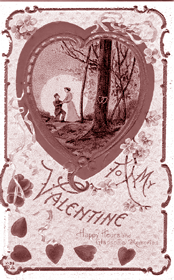
Another on the side of the cupids is David Hilton, poet and professor of poetry at Anne Arundel Community College, whose wife will receive a newly written poem at breakfast on Valentine's day. "I'll bet that way, way back, poetry was brought forth by the mysterious attraction toward another human being," he says.
A Day to Warm Winter Hearts
The holiday's midwinter timing is no accident, though in the beginning the occasion had more to do with lust than love. Nor is there anything store-bought or artificial about the origins of this holiday. Its roots are ancient, tapping to the Roman fertility festival of Lupercalia about this time of year, when longer days and the first green shoots assure us that spring will indeed return.
Chilly though February may seem, the whole month takes its name from Juno Februata, the mother-goddess in her amorous or fevered state. Birds, so the legend goes, choose their mates on the Ides of February. We have that on the good authority of 14th century English poet Geoffrey Chaucer:
For this was on Saint
Valentine's Day
When every fowl cometh to choose his mate
Humans followed suit on Lupercalia, which took its name from the Roman god Lupercus. He, like the better known Faunus, was a shepherd. Fertility was their doing, and the lusty Faunus became incarnate as half goat. The exchange of love notes began all those centuries ago when men drew in lottery the names of the woman with whom they'd imitate the birds. In chaster forms, the custom continued at least into the 18th century. Remember those origins and blush as you choose this year's valentine cards.
When the Roman Empire went Christian, the old feast set the Fathers of the Church blushing. But there was no stamping out such holidays; the old urges were irrepressible. So the old pagan feast days were cleaned up. When Lupercalia was Christianized, Saint Valentine was drafted into the role of Cupid, the little love-messenger who was mythology's G-rated version of the X-rated Faunus.
Explanations differ on why the early and perhaps mythical martyr Valentine got the job. In one story, he carried messages for Christians imprisoned for their faith - and often their chastity. In another, he was himself in prison, where he cured his jailer's daughter of blindness before going to his death. For the girl, he left behind a note signed only "from your Valentine."
Late 20th Century Love Notes
Millennia later, the same old urges are urgent as ever. About the time the groundhog seeks his shadow, the birds start singing and the sap starts rising, valentine cards - and all the holiday's attendant parade of hearts, chocolates and flowers - make their annual appearance. If your blood hasn't yet warmed, all this paraphernalia is the alarm that warns you not to miss out on the mating season.
Wooing has become big business in our time. The holiday is the greeting card industry's second largest sales day. Nine hundred million cards are exchanged, from inexpensive boxed valentines favored by school children to over-sized elegant cards costing up to $6.50.
Only a fraction of those cards are exchanged by lovers. According to industry tracking, 80 percent are purchased for relatives: children, mothers and wives, in that order, with sweethearts, who we guess aren't related, following. Eighty-five percent of valentine card buyers are women, but children give the most cards: 650 million out of 900 million. Teachers get more cards than anybody else.
Thus industry-leading Hallmark makes cards to "honor many relationships."
As well as natural mothers and fathers, sisters and brothers, there are
cards for step relatives in all sorts of combinations, Buckley says. Even
people who've lost loved ones are not forgotten by Hallmark, which this
year is introducing its 'Bittersweet Offering.'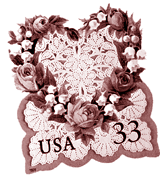
Bittersweet Offerings respond to consumer demand, Buckley says, as do 'Real Life, Real Relationship' cards: "Consumers say they like cards with long messages and rhymes, with hearts and lovers and red and pink, but they also want very authentic cards that talk like we talk." These are printed in sepia with "slice-of-life" photos. One shows a mother reading to a daughter in her lap. Inside, the message reads: "You've mommed me well."
But the old stand-bys still lead the field. Humorous cards fill a quarter of the market, and spicy to torrid cards have their niche, but romantic cards remain best sellers. Especially popular this year are cards in the Victorian style, embellished with fine color, die cuts, tiers, attachments, moving parts, laces, flocking and handwork.
The U.S. Postal Service is joining in the Victorian revival, with new Victorian-style 33- and 55-cent love stamps for Valentine's Day. Both are lace on pastel backgrounds topped by hearts of roses and lilies of the valley. They are, the Postal Service notes, the first stamps die-cut to the shape of their image.
All those refinements make the valentine card more, says Buckley, than a card: "It's a keepsake," the holiday specialist says. "These are the one card people hold onto over the years." A story makes her point.
"A man in his 90s - he was essentially dying - came to Hallmark in his wheelchair with the valentine his father gave to his mother when he proposed in the 1890s. That was because he could trust us to keep it and we did, framed and matted."
Making On-line Love
Nowadays, of course, your valentine can be electronic.
You don't get the tactile pleasures of picking the perfect valentine, but you do get to personalize lots of choices to custom-make your own electronic valentines. What's more, they're often free.
To take advantage of this technological advance in romance, you need access to the World Wide Web, an e-mail account and the e-mail address of your special friend. The recipient of your e-card must also have access to the Web.
After deciding which of the several sites to use, you make a series of personalizing decisions. Which card to send, of course. What shall you say? How about some music: classical, rock, musak? When do you want the greeting card sent? Many of the valentines have simple animated features. All invite you to write your own message.
Once you've created your valentine, enter your e-mail address and that of your sweetheart and click on send. An e-mail message will be sent to your sweetie, telling him or her that you've sent a card and including the WWW address where the card can be picked up. Most of these virtual card shops provide links to the pick-up site; some require that the recipient enter an access code for pick-up. The valentine can usually be viewed for about two weeks or can be downloaded into a file as a permanent record of your electronic sentiment.
Behind the scenes of both traditional and e-mail cards, market researchers, writers, artists and lettering specialists make like so many Cyrano de Bergeracs to win love for people who lack the confidence, time or skill to speak for themselves. If you're tired of being tongue-tied, read on to learn the language of love.
Language of Love
Over the centuries the language of love has given us some very pretty expressions. After all, "love," Professor Hilton reminds us, "invented poetry. Poetry - or chocolate - is the language of love."
Hilton says he hasn't paid money for a commercial greeting card in years. On the early morning of love's day, he'll "sit down, start with a line and take my chances. It's not my normal way," the poet confessed, "but I don't want to impose art and craft. I hope those qualities will be in the poem, but it's got to be spontaneous."
If you, too, believe love's expressions should be your own - essential, spontaneous and primal - you can prime your pump with poetry. It's a subject on which few (if any) poets have kept silent, so over the centuries some pretty good tricks have developed in the trade. You'll find some or all of them in any love poem worth its salt - as well as in many on-the-shelf valentines.
Begin by praising the qualities of the one you love. Compare her or him to the finest, dearest things under the sun. Nature is the oldest and still surest source of inspiration:
O, my luve's like a red, red rose,
That's newly sprung in June;
O, my luve's like the melodie
That's sweetly played in tune
wrote the Scots poet Bobbie Burns, setting the unsurpassed standard for simplicity.
Will Shakespeare's comparisons were more complicated -
Shall I compare thee to a summer's day?
Thou art more lovely and more temperate;
Rough winds do shake the darling buds of May,
And summer's lease hath all too short a date
- but the formula is the same.
More recently, art, technology and commerce have given our love poets some nice comparisons, with nobody using them better than Cole Porter:
You're the tops, you're a Shakespeare sonnet
Even so, you can't top nature's nubile fecundity when you're wooing by comparison.
Next, the wooer describes the quality of love offered, concentrating on its depth and endurance
I'll love you, dear, I'll love you
Till China and Africa meet
And the river jumps over the mountain
And the salmon sing in the street
wrote American poet W.H. Auden.
It's also well to touch on the lengths to which the wooer will go, the terrors that would be dared and the wonders worked for love's sake. Thus:
I gave my love a cherry that had no stone.
I gave my love a chicken that had no bone
Then comes the pleasures the joined lovers will share
And I will make thee beds of roses,
And a thousand fragrant posies,
A cap of flowers and a kirtle
Embroidered all with leaves of myrtle
wrote the 16th century poet Christopher Marlow in a get-back-to-the-country mood. A modern troubadour traveled to space to express bliss:
Fly me to the moon and let me play among the stars. Let me see what spring is like on Jupiter and Mars
Emily Dickinson - who would have thought of her as a love poet? - wrote one of Hilton's favorites:
Wild Nights - Wild Nights
Were I with thee
Wild Nights should be
Our luxury!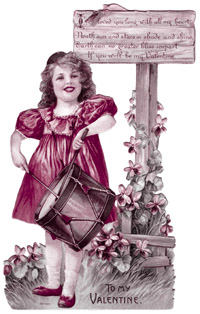
"I love this passionate outpouring with its touch of irrationality controlled by form," says Hilton.
Next, the poet describes the transcendence the lovers will achieve. Again, Shakespeare set the standard. Here's how the master finished his Summer's Day sonnet:
So long as men can breathe or eyes can see,
So long lives this and this gives life to thee.
Finally, comes the pitch:
Come live with me and be my love, and we will all the pleasures prove
wrote the saucy Marlow, with a directness admired by our era.
Love's been so popular a subject so long that it's acquired a language of symbols as well as of words. Animal and plant kingdoms lend their qualities, real or mythic, to the depiction of love. In the language of the flowers, rosemary and myrtle, both evergreens, conquer time, with rosemary symbolizing remembrance and myrtle, as in Marlow's poem, lasting love. The violet stands for modesty and the daisy for innocence. The red rose stands for desire, the white for innocence and the pink for happiness.
Among the animal kingdom, the dog stands for fidelity, which is how so many dogs got named Fido. But watch out for goats and monkeys, for they'll tip your love off to the lustful nature of your appeal. Cats suggest you'll be clever and ruthless in love's pursuit, while birds and bees stand for the birds and the bees.
Seventeenth-century poet Robert Herrick, who always wrote a pretty line, took his inspiration from the birds in his 1648 poem "To His Valentine, on St. Valentine's Day":
Oft have I heard both youths and virgins say
Birds choose their mates, and couple too this day:
But by their flight I never can divine
When I shall couple with my Valentine.
If you still don't trust yourself to speak the language of love, the World Wide Web gives you a safety net. Dial up The Cyrano Server. You type in names and a few descriptive features; Cyrano steps in to finish your letter in steamy, humorous or poetic style.
That clever technology is nothing new under the sun. Citizens of earlier centuries consulted their Valentine Writers. "The little books catered to every taste, from the heavy sentimental to the comic to the lewd," note curators Janet Abshier and Laurie Verge in the Surratt House Museum's guide to their annual valentine exhibit.
Be My Valentine
For most of us, love's best token remains the valentine. Twentieth century
Americans grew up on them. Except in wartime or Depression, few schools
were too rural or too poor to ignore the custom of the valentine exchange.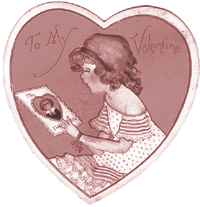
"Even when I was in school, Valentine's Day was a big deal," recalls Laurie Verge, director of Surratt House Museum in Clinton, of her post-World War II schooldays. "Someone was chosen to bring in the biggest box, and the children decorated it."
Janie White, of Shady Side, who grew up in Washington, D.C., remembers the same custom from the Depression, except that the Valentine box was the big, waxed cardboard box from the graham crackers the school provided with afternoon milk. "In those times, you couldn't afford many valentines, and you always hoped you got one," White recalls.
Many of the cards you see in this story were Illinois schoolchildren's valentines presented to their country schoolteacher, Miss Cora Smith, in the early teens and '20s of the century. Handmade on lined school paper, simple (and sometimes oddly sweetheartish) or elaborate, with tiers, embossing, pop-outs of honeycomb paper and moving parts - they were too precious to be thrown away.
Which is how Surratt House got to be the place to go this time every year to revisit the Golden Age of Valentines.
Explains Verge: "My family has lived in the same house since 1860, and my mom knew of two valentines sent by my great-grandfather in that year. When Surratt House was planning our first exhibit of valentines in 1977, my husband and I went through the house, searching books and drawers, and came up with an antique card collection.
"Then he would scour shops for old cards to give me on holidays because he knew I'd throw new ones away."
Her collection of over 100 cards ranging from the 1840s to the 1940s shows why so many valentine cards have outlived the friends and lovers who sent them: "They are so gorgeous, you can't look and not see their appeal," says Verge.
Her oldest is a witty love poem dated 1848 and written in a fine hand on a hand-made card of paper pricked with a pin to resemble lace, a technique passed down by monk-illuminators of centuries earlier. Other fancy techniques traveled to America with Germans emigrating to Pennsylvania in the late 1700s and 1800s.
"In America in the 1840s and '50s, Valentine's Day was the number-one time to send greeting cards," Verge explains. "They were not sent frivolously. You sent the large, ornate, beautiful ones to people you really cared for. My great-grandfather sent his in February, 1860 and he and my great-grandmother were married in November, so the card must have done the trick."
By the 1870s and '80s, Verge speculates, "elaborate cards became popular with the rising middle class, enriched by the industrial revolution, who invested in nicer things to achieve an image."
Traditions of Germany and England combined to bring the valentine's card - first handmade, then elaborately manufactured - to America. From the Germans came a good deal of the technology, including cut paper, tiers, pop-outs and moving parts. The Victorians contributed beautiful lacy valentines with hearts and flowers - but not too much red.
"Red was a hussy color. A lady would never have worn anything solid red until the Gay '90s," notes Verge. "Plus printers say red is a hard color to achieve. So Victorian colors tended to pale blues, greens and pinks. In the 1870s and '80s, German immigrant Louis Prang advertised he could print 23 different colors, creating fine pastel effects like oil paintings. He also added silk borders to cards.
A second founder of the greeting card industry in America was Esther Howland, from Massachusetts, who Verge credits as the "first person to bring mass production into play." Inspired by English valentine kits, she organized friends into an assembly line, adding lace and stickers and hand paintin to a card base. With her stationer father her supplier and her brother her salesman, Howland established a company that continued, in other hands, until 1942, when wartime paper shortages forced it out of business.
Around the turn of the century, postcards were invented, and valentines migrated to that form, too.
Each era has added its own twist - including, in ours, cartoon characters - because, for one reason or another, St. Valentine's Day exchanges of love tokens seem to be a tradition we can't do without.
Not So Secret Anymore
Back in Saint Valentine's own day, love notes were exchanged in secrecy. Today's love is proffered more boldly, even blatantly. Suitors proclaim their love for all to see, aided by technologies that make it unnecessary to climb to the highest mountain and shout.
You can, for example, post your love on a billboard or a bus. You can even fly your message in the sky, not - we're sorry to say - as skywriting, but as a towed banner. Love messages that fly through the air grab the attention of the beloved as well as neighbors and strangers.
"People who hire me to fly personal messages are people who do off-the-wall stuff," explains Chip Gnau, owner and pilot of Bi-Plane Aerial Towing Services.
He should know. Chip's proposal to now-spouse Tami made unique use of his bi-plane. He took Tami up in his plane. The banner 'I love you. Will you marry me?' with a big heart at the end covered his grandmother's yard. He flew over it, brought tears to Tami's eyes and was rewarded with a yes.
What does it take to send a very public private message? A dozen spectacular red roses costs $95. Messages from the sky cost a little more: $150-$300 an hour, banner included, depending on the company and location of the fly-by.
Frank Butler, owner-pilot of Beltway Banners Aerial Advertising, gets "lots of requests for marriage proposals, but a majority don't follow through, probably because of the cost." Romanticism and deep pockets are a must for the few Butler calls "romantics in nature who want to do something unique."
Besides the messages of love and proposals, banners in the sky carry apologies, so after the love message on Valentine's Day, banner towing can be used for patching up broken hearts. Phoenix Air Ads once flew a banner proclaiming "I'm sorry I was such a jerk. Forgive me."
That's no surprise. Love more often ends than begins in public. In our kiss-and-tell culture, there's more reason than ever to sign yourself "A Secret Admirer" - if you write at all.
"Today nothing ever stays private," advises Marlin Fitzwater, spokesman for Presidents Ronald Reagan and George Bush.
Adds Fitzwater: "You have to be extraordinarily careful what you write in this era of independent counsels of every sort. In an age of subpoenaed hard drives, you'd better make it pretty pristine language."
Kim Cammarata contributed to this story.
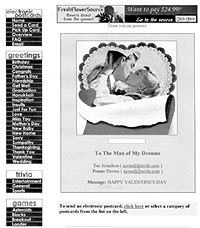
Electronic Love Notes
Try an e-mail valentine at any of these sites. All include easy directions for sending your free e-card.
Or try the Cyrano Server:
Aerial Love Notes
You can proclaim your love on high with any of these services. Prices range from $150 to $400 an hour.
-CG
-DA
Just the Right Card by Donna Ayres
It used to be pretty simple when we were kids. Our mother would buy us a box of cheap valentines.
Remember those flimsy, often heart-shaped cards? They'd have simple messages,
like "Happy Valentine's Day to a Real Sweetheart" or "Hope
your Valentine's Day is Special, Just Like You!" The envelopes provided
were so cheap that they had visible specks of paper pulp.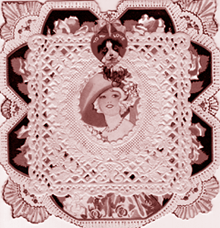
After mom gave us our very own box of valentines, we'd have to decide which card to send to which friend. The tough part, of course, was deciding which one to send to that classmate we had a crush on. The card that said, "Will You Be My Valentine?" Of course, you could send it anonymously.
As an adult, it's a little trickier: the stakes are often higher. If we're dating, the valentine has to achieve just the right tone. It has to match the level of commitment we think the other person feels. Thus explains the scene in a greeting card shop around February 10 or 11.
The teenage girl, usually accompanied by a friend, is the most intense. Often giggly and unsure, she looks at a dozen or so cards until she finds the perfect valentine for her boyfriend (or hoped-to-be boyfriend).
The adult woman is pensive, with furrowed brows, or carefree, with a confident smile. She too looks carefully before deciding which missive to send to her sweetheart.
I'm one of the women with the confident smiles. Being an almost newlywed (just married for three years), I'm still enthralled by romance. I'm also crazy about the pleasures of paper. I love the textures, the colors and the designs of greeting cards. Electronic card shops just won't do for me; they rob me of the sense of touch I enjoy so much.
Valentines in particular offer me an adventure in stationery selection. I take it relatively seriously, often checking out more than one store. I'll spend time at my local card shop as well as at the large chain drug stores. I've even found great cards at K-Mart. However, all the cards I consider (and buy) must be of high quality. No flimsy, cheap Valentine for my sweetheart!
Heavy, textured cards are my favorite, not the glossy, smooth ones. The more modern designs are appealing, the ones with bold, strong strokes and colors. Pink cupids and red roses leave me unsatisfied. The sentiment should be simple but relevant: reflective of the nature of the relationship at this point in time. What fun!
Some of the shoppers are guys, mostly all adults. They're often the ones who can make a split-second decision. (Those roses are pretty; they'll get that card; it's just something they have to do). Once in a while, however, you can observe the man who takes romance seriously. He'll look just as pensive as the women, just as unsure as the teenage girls. He too checks out a dozen or so valentines until he finds the one that expresses his love just right. My guy is one of those.
The ritual of choosing the perfect valentine may be different for each of us. The object of our search, however, is the same. The annual rite of finding that special piece of paper that expresses our love is a reminder that we do love and that we are loved - and that it's important to send the message.
| Issue 6 |
VolumeVII Number 6
February 11-17, 1999
New Bay Times
| Homepage |
| Back to Archives |